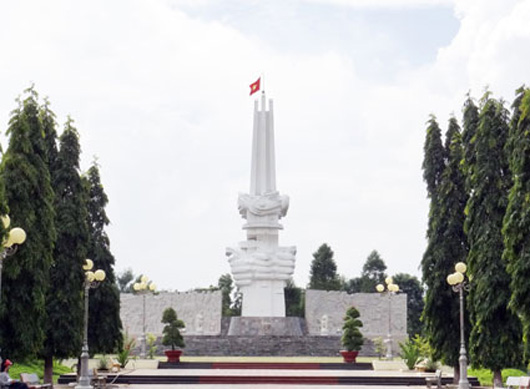Mentioning Binh Gia victory, late General Hoang Van Thai, former Deputy Defence Minister stated that this was “a small scale operation but of strategic importance which opened up a new stage of the Southern revolutionary war”.
 |
|
Binh Gia Victory Monument in Ngai Giao town, Chau Duc district, Ba Ria - Vung Tau province today |
Binh Gia campaign lasted from 2nd December 1964 to 3rd January 1965 and was divided into two phases: phase 1 lasted from 2nd to 17th December 1964 and phase 2 lasted from 27th December 1964 to 3rd January 1965. The campaign ending victoriously destroyed 1,700 enemy troops, captured 300 others, defeated 2 enemy’s regular battalion, 1 armored battalion and some security companies; destroyed 45 vehicles, mainly M113 armored personnel carriers; shot down and damaged 56 aircraft (mainly helicopters), captured 1.000 guns of different kinds and 100 radios. The significance of Binh Gia victory went beyond campaign scale to strategic level.
To ensure victory, the High Command of the South Vietnam Liberation Army (SVLA) paid special attention to promoting the capability of armed forces and local people to prepare logistic and technical supplies for the campaign. Guideline of the Military Party Committee (MPC) and the High Command of the SVLA was to combine closely the logistics of upper level and the logistics on the spot with the latter being the focus. Collaboration was also to be done thoroughly among forces. Prior to the launch of the campaign, the High Command ordered southeastern armed forces to push up offensive operations against the enemy throughout the battlefields focusing on Bien Hoa airbase to make a diversion in order to attract and lure the enemy to different directions, maintain secrecy and minimize the involvement of the enemy air force. To implement the guideline, armed forces of the SVLA along with local people of the southeastern provinces launched attacks on several enemy bases and destroyed a number of strategic hamlets in the districts of Hoai Duc, Dat Do, Long Thanh far away from the campaign’s ground, liberating the coastal Pho Tri village of Ham Tan district and openning up a sea route to get goods transported from the North. Along the road 15, the Battalion 800 of Military Region 7 separated, surrounded and isolated the enemy and destroyed completely their convoy. Thanks to the help of local people and armed forces, the U80 artillery unit of the SVLA secretly deployed their weapons close to Bien Hoa airbase, gaining offensive advantage and enhancing fighting efficacy. Being attacked suddenly all round, including the heavy damage of Bien Hoa airbase – the symbol of the US Air-Force strength. 59 aircraft and many other pilots, technicians, security men were destroyed. MPC and High Command of the SVLA were creative and reasonable to launch attacks on almost every ground and on the most powerful and unattended installation of the enemy which made them falsely predict our real intention and even deploy their troops far away from Binh Gia.
This victory was typical of the development of the Southern revolutionary war, contributing greatly to the victory of the campaign. The High Command anticipated that when reinforcing, the enemy would utilize their air force at utmost to gain advantage. So the High Command ordered the campaign’s air defence force to make a reconnaissance of the terrain, identify flight direction, air route and landing field and choose a favourable location to prepare and implement ambush the enemy aircraft and landing troops. Thereby, the SVLA set up a flexible, dense and multi-layered air defence disposition covering the aerial fleet – the pride of the Army of the Republic of Vietnam. For this reason, most of the enemy’s aircraft once taking off for the battle couldn’t return to their base. In the first battle on 9th December 1964, the SVLA shot down 4 aircraft, including 3 armed helicopters and 1 reconnaissance aircraft and damaged three other helicopters. On 28th December 1964, the enemy deployed 24 armed helicopters to escort 50 transport helicopters to land troops to the northeast of Binh Gia, collaborating with their Battalion 30 in the west with the aim of reoccupying the village. However, they fell into our ambush and couldn’t land on the northeastern side and were forced to land on southeastern side. Finally, we shot down 18 aircraft, and destroyed completely Battalion 33 and heavily damaged Battalion 30 when they just landed.
The victory of Binh Gia campaign showed the comprehensive development of the revolution in the South. The victory made the US Defense Department confess that “Washington’s disappointment about the military situation escalated as Saigon Army was heavily beaten in Binh Gia battle… All proofs showed a clear likelihood of a final fall of the South Vietnam Government and Viet Cong’s reinforcement their strength”.
Colonel, Pham Duc Truong, MA
Vietnam Military History Institute